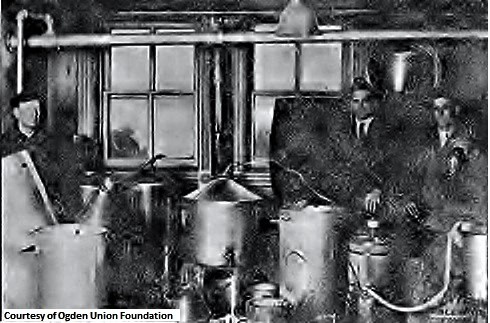Dublin Core
Title
Description
Learn how Ogden’s families and business-owners used the prohibition against alcohol to invent new styles of work… and how law enforcement worked to stop them.
July 31, 1917 marked the last night before Prohibition in Utah, a new law that banned the production and sale of alcohol. The Ogden Standard reported that, “Men drank tonight who never drank before. Women thronged the cafes wherever there was a connecting saloon; and young boys, some of them not more than fifteen years of age, were noted in large numbers staggering the streets.” The next day, saloons ‘redecorated’ their premises into soda shops, dance floors, and restaurants. And to keep the booze flowing, they relied on bootleggers to make and distribute the now-illegal beverage.
In Ogden, speakeasies sprung up in the basements of businesses. One Italian business owner built a false wall in the basement of his soda shop and put a copper still behind it. The still was connected to the plumbing that led to the sink in the bathroom. Those who knew which faucet to turn would get whiskey instead of water. But it wasn’t just men who got into the bootlegging business. Mothers needing to feed their families welcomed the opportunity to earn extra cash. Some Greek and Italian women, for example, crushed grapes to produce wine. When fresh grapes weren’t available, they soaked raisins in a corked jug for twenty-one days until they were plump enough to process.
As the bootleggers got more innovative, local law enforcement countered their moves. Weber County Sheriff Deputy David F. Steele was well known for using his keen sense of smell to sniff out whiskey and catch bootleggers. He would drive around the county with his windows rolled down in order to detect the smell of fermenting grain. He busted two stills per week using his unusual talent.
The government implemented Prohibition in an effort to uphold community morals and stop the supposed ‘evils’ that came with alcohol. On Ogden’s Twenty-Fifth Street, however, it had the opposite effect. It created a culture of crime and clandestine behavior, and inspired a remarkable period of business innovation.
Creator
Annie Bommer for the Ogden Union Station © 2017
Source
Image: “Largest Prohibition Operation Found in Weber County to Date,” from the Ogden Standard-Examiner, December 28, 1920. Image courtesy Union Station Foundation.
______________
See Ogden Standard, August 1, 1917; Joseph Prantil, “Twenty-Fifth Street: The City That Never Slept,” interview with Sarah Singh, Business at the Crossroads – Ogden City Oral History Project, Weber State University Stewart Library Special Collections, July 17, 2013, p 3; Helen Z. Papanikolas, “Bootlegging in Zion: Making and Selling the ‘Good Stuff’,” Utah Historical Quarterly 53 no. 3 (Summer 1985), pp 268-91; Val Holley, 25th Street Confidential: Drama, Decadence, and Dissipation along Ogden’s Rowdiest Road, Salt Lake City: University of Utah Press, 2013; Edward Behr, Prohibition: Thirteen Years that Changed America, New York: Arcade Publishing, 1996; Ogden Standard-Examiner, October 8, 1972; Kenneth D. Rose, American Women and the Repeal of Prohibition, New York: New York University Press, 1996; W. Paul Reeve, “Prohibition Failed to Stop the Liquor Flow in Utah,” History Blazer, Utah Historical Society, February 1995.

